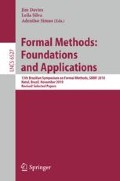Abstract
Multi-agent systems are employed to model complex systems which can be decomposed into several interacting pieces called agents. In such systems, agents exist, evolve and interact within an environment. In this paper we present a model for the specification of such environments. This Environment Model for Multi-Agent Systems (EMMAS), as we call it, defines both structural and dynamic aspects of environments. Structurally, EMMAS connects agents by a social network, in which the link between agents is specified as the capability that one agent has to act upon another. Dynamically, EMMAS provides operations that can be composed together in order to create a number of different environmental situations and to respond appropriately to agents’ actions. These features are founded on a mathematical model that we provide and that defines rigorously what constitutes an environment. Formality is achieved by employing the π-calculus process algebra in order to give the semantics of this model. This allows, in particular, a simple characterization of the evolution of the environment structure. Moreover, owing to this formal semantics, it is possible to perform formal analyses on environments thus described. For the sake of illustration, a concrete example of environment specification using EMMAS is also given.
Access this chapter
Tax calculation will be finalised at checkout
Purchases are for personal use only
Preview
Unable to display preview. Download preview PDF.
References
Fournet, C., Gonthier, G.: The join calculus: A language for distributed mobile programming. In: Barthe, G., Dybjer, P., Pinto, L., Saraiva, J. (eds.) APPSEM 2000. LNCS, vol. 2395, pp. 268–332. Springer, Heidelberg (2002)
Gilbert, N., Bankers, S.: Platforms and methods for agent-based modeling. Proceedings of the National Academy of Sciences of the United States 99(supplement 3) (2002)
Luke, S., Cioffi-Revilla, C., Panait, L., Sullivan, K.: MASON: A new multi-agent simulation toolkit (2004), http://cs.gmu.edu/~eclab/projects/mason/
Milner, R.: Communicating and Mobile Systems: the Pi-Calculus. Cambridge University Press, Cambridge (1999)
Minar, N., Burkhart, R., Langton, C., Askenazi, M.: The Swarm simulation system: A toolkit for building multi-agent simulations (1996), working Paper 96-06-042
North, M., Collier, N., Vos, J.R.: Experiences creating three implementations of the Repast agent modeling toolkit. ACM Transactions on Modeling and Computer Simulation 16(1), 1–25 (2006), http://repast.sourceforge.net/
Parrow, J.: An introduction to the pi-calculus. In: Bergstra, J.A., Ponse, A., Smolka, S.A. (eds.) Handbook of Process Algebra, pp. 479–543. Elsevier, Amsterdam (2001)
Pierce, B.C., Turner, D.N.: Pict: A programming language based on the pi-calculus. In: Plotkin, G., Stirling, C., Tofte, M. (eds.) Proof, Language and Interaction: Essays in Honour of Robin Milner. MIT Press, Cambridge (1997)
da Silva, P.S.: An environment specification language for multi-agent systems, Technical Report 1531 – Université Paris-Sud 11, Laboratoire de Recherche en Informatique (2009)
da Silva, P.S., de Melo, A.C.V.: A simulation-oriented formalization for a psychological theory. In: Dwyer, M.B., Lopes, A. (eds.) FASE 2007. LNCS, vol. 4422, pp. 42–56. Springer, Heidelberg (2007)
Skinner, B.F.: Science and Human Behavior. The Free Press, New York (1953)
Wang, J., Wysk, R.A.: A pi-calculus formalism for discrete event simulation. In: WSC 2008: Proceedings of the 40th Conference on Winter Simulation, Miami, Florida, pp. 703–711 (2008)
Weiss, G. (ed.): Multiagent systems: a modern approach to distributed artificial intelligence. MIT Press, Cambridge (1999)
Weyns, D., Van Dyke Parunak, H., Michel, F., Holvoet, T., Ferber, J.: Environments for multiagent systems: State-of-the-art and research challenges. In: Weyns, D., et al. (eds.) E4MAS 2004. LNCS (LNAI), vol. 3374, pp. 1–47. Springer, Heidelberg (2005)
Author information
Authors and Affiliations
Editor information
Editors and Affiliations
Rights and permissions
Copyright information
© 2011 Springer-Verlag Berlin Heidelberg
About this paper
Cite this paper
da Silva, P.S., de Melo, A.C.V. (2011). A Formal Environment Model for Multi-Agent Systems. In: Davies, J., Silva, L., Simao, A. (eds) Formal Methods: Foundations and Applications. SBMF 2010. Lecture Notes in Computer Science, vol 6527. Springer, Berlin, Heidelberg. https://doi.org/10.1007/978-3-642-19829-8_5
Download citation
DOI: https://doi.org/10.1007/978-3-642-19829-8_5
Publisher Name: Springer, Berlin, Heidelberg
Print ISBN: 978-3-642-19828-1
Online ISBN: 978-3-642-19829-8
eBook Packages: Computer ScienceComputer Science (R0)

